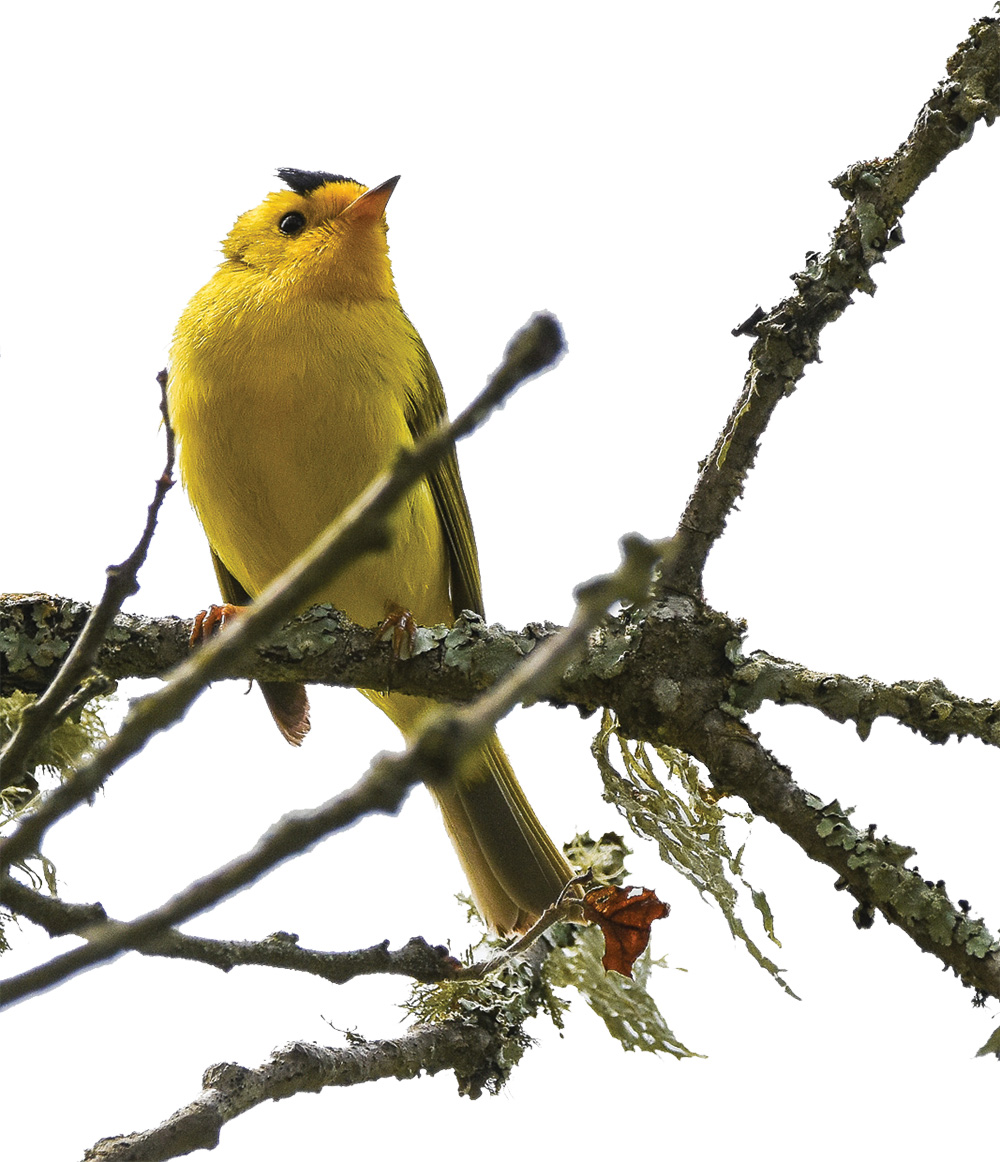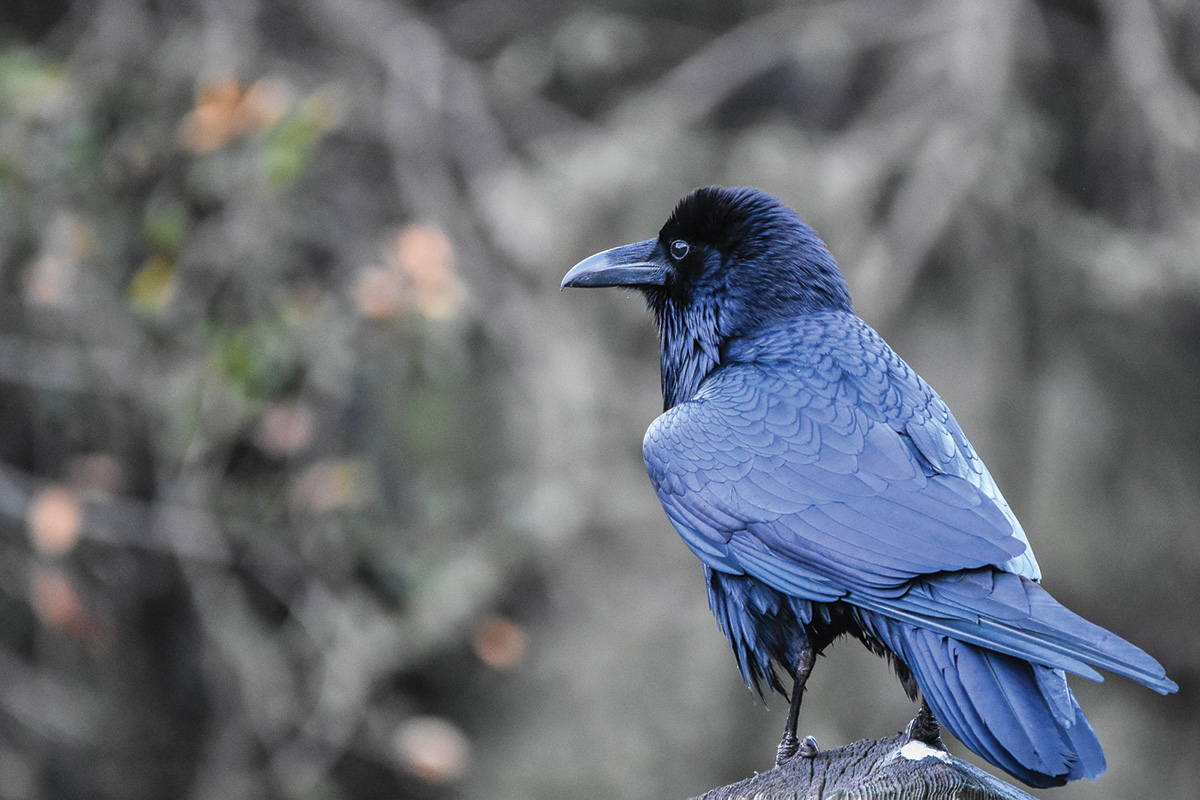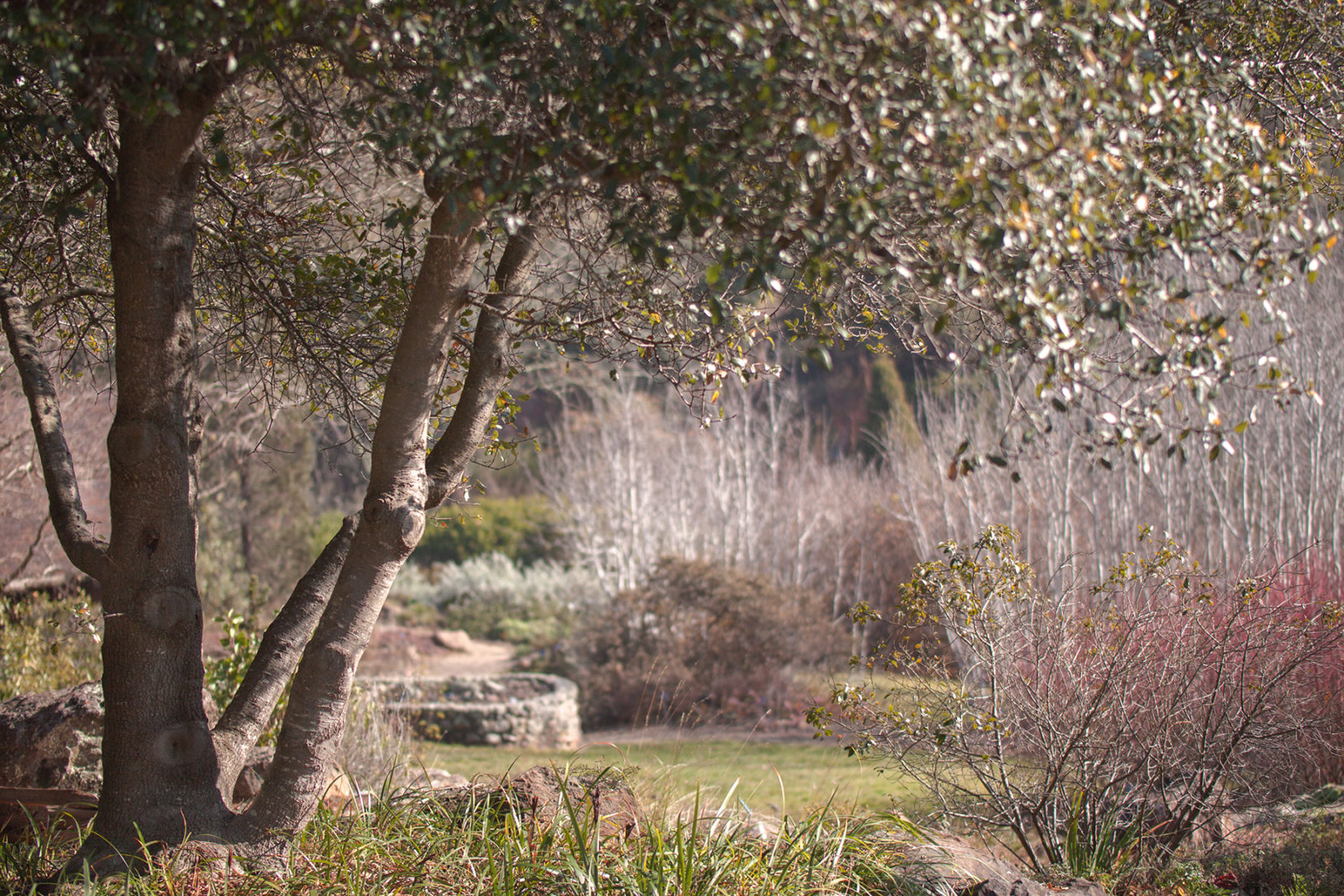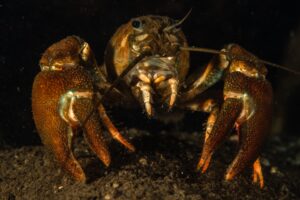It’s a free-for-all among the Fort Miller clarkias. Five lesser goldfinches are jabbing with stubby bills at the shriveled seed heads still clinging to the waist-high stems. The flowers—delicate cups of hot pink and lavender—nod as the birds hop from plant to plant. Olive, black, and yellow plumage flashes with each chit chit and flutter.
It takes a lot of the chestnut-brown, teardrop-shaped clarkia seeds to satisfy a bird. Each granule is only slightly larger than a poppy seed, and the birds linger to get their fill. That’s fine by the people watching the mealtime drama unfold from across the lawn—this is exactly the kind of scene that draws them to survey birds in the Regional Parks Botanic Garden, a living museum of native California plants in the East Bay.
“I love the way goldfinches can hold on even as the stems dip under their weight; they have no problem with that,” says Ellen Sampson.
“It’s the same plants we saw them at last week,” says her colleague Wen Hsu.
A moment later, the little flock wings off toward the Redwood section of the garden. The birders lower their binoculars and pause a moment in appreciation. The small spectacle they’ve just witnessed is the reason this group has been walking through the garden roughly every two weeks for five years.
The Botanic Garden Bird Survey Team has recorded all of the birds they’ve observed in this corner of Tilden Regional Park, specifically tracking which species visit and when, what they eat, and the materials they use to build nests. Their efforts not only reveal how birds interact with native plant species, but have given the birders a new appreciation of a place they hold close to their hearts.
“The bonus of birding in the garden is the fabulous garden itself. You get to see what’s in bloom, what comes out annually or perennially, when trees are fruiting or flowering or losing their leaves. It’s a gem,” Sampson says.
Tucked into the valley that bisects Tilden Regional Park, the 10.5-acre botanic garden holds hundreds of species that span ten bioregions throughout California. Despite being the smallest of the public gardens in California devoted to native plants, it has a greater variety of plant taxa than the other two such gardens, which are more than eight times larger.
The garden can grow native plants from a particularly wide range of habitats thanks to its microclimate. “Here in a canyon along Wildcat Creek, we get a little hotter, and a little colder, and offer lots of niches to grow a wide array of native plants,” says botanic garden manager Bart O’Brien.
A Team is Born
The birding team grew out of the garden’s thriving docent program. The more than 125 active docents, each of whom goes through an intensive six-month training program, lead more than 225 or so public garden tours every year.
After training as a docent, Hsu decided to start a bird survey of the garden, realizing she could meld two of her longtime passions—birds and native plants. “From the beginning I knew that if I wanted to know what birds are here, I couldn’t do it by myself,” she adds. “If it was just by myself, I knew it would be very easy to stop if it’s too cold or too warm. If you have a commitment to a group, you have to be there.”
Hsu reached out to fellow docents Sampson and Kitty Whiteside, who she knew were already skilled birders. The three have since been joined by more docents and even some garden staff. These days, team stalwarts include Hsu’s husband Minder Cheng, who specializes in taking bird photos; Rosie Andrews, president of the Friends of the Regional Parks Botanic Garden; and plant ecologist Allison Kidder.

The team could have based their survey at any number of spots in the Bay Area. The region is dotted with places where native plants offer bountiful bird habitat. But the garden, with its unparalleled range of California’s botanical diversity, had an ineluctable pull.
Bioregions represented in the garden range from the desert to the Pacific rainforest, the Channel Islands to sea bluffs, and valley foothills to the Shasta-Klamath region. “It’s an opportunity to see how the birds use all of these habitats,” Kidder says.
“What drew me to the garden is the fact every species is an accessioned museum piece. But it’s better than a typical museum because all of the plants are alive, and you can see how they’re growing and what they provide to other animals.”
As specimens would be in any museum, the plants in the garden are labeled with species name, collection date, and region. The labels make documenting how birds use different plants much easier.
A good example of what the plants provide comes from the garden’s 90 species of manzanita as they bloom in winter. Flocks of golden-crowned sparrows—which fly from their breeding grounds in northern Canada and Alaska along the Pacific slope every fall—feed primarily on the whole flower of at least six different manzanita species, according to three years of the team’s surveys. And whenever they have spotted Anna’s hummingbirds sipping nectar, it’s been almost exclusively from eight species of manzanita blooms that are entirely different from those visited by the golden-crowned sparrows.

Who’s Doing What in the Garden
The team records its avian observations in eBird, a mobile app developed by the Cornell Lab of Ornithology. The app can automatically generate checklists annotated with months of the year and habitats where birds were noticed. This versatility, together with the ability to parse data from all participants, has made the eBird’s data valuable to scientists studying bird populations and migrations around the world.
The 81 bird species on the survey team’s checklist range from residents, such as spotted towhees and acorn woodpeckers, to flyovers such as bald eagles, to seasonal migrants like golden-crowned sparrows.
The team keeps a separate record of observed plant-bird interactions. From their hundreds of entries they’ve identified the plant species most kinds of birds use for food. The translucent crimson fruits of Nevin’s barberry (Berberis nevinii) have attracted a record seven species of hungry songbirds. That the plant is endemic to Southern California chaparral and would not occur naturally in the Bay Area doesn’t seem to bother its diners.
“I knew I was always seeing different birds in the Nevin’s barberry, which is located near the entrance,” garden manager O’Brien says. “But the birding team actually quantified that.”
Another flock-pleasing plant species is the red-osier dogwood (Cornus sericea). The group has observed six bird species feeding on its clusters of plump white berries in the fall.
Birds of course are famous for using plants to build their nests. The team keeps eyes peeled in spring for birds toting grasses, sticks, and lichens in their beaks—sure signs nest construction is underway. Following the builder is often the best way to locate these structures.
“Nests are an integral part of the whole picture of birdlife in the garden,” Andrews says. “They give us a picture of what’s breeding here versus what’s passing by for food. It’s always fun to see them raising young.”
The team has spotted Steller’s jays collecting mud and rotting leaves from the creek to plaster together assemblages of sticks. They have found hummingbird nests the size of a golf ball and observed tiny bushtits peeling lichen flakes from tree branches to camouflage their nests: dangling, socklike woven sacks.
The bushtits “dive in to the bottom, and when they move around, the whole nest shakes back and forth,” Sampson says.
The garden has an extraordinary number of habitats juxtaposed within a very small area, which enhances its appeal to wild birds. “Generally you find birds on the edges of ecosystems, ecotones like between grassland and shrubland,” Kidder says. “They like the cover of trees but the grassland for catching bugs for example. There’s a ton of that structural diversity in the garden.”
Structural diversity makes the bridge over Wildcat Creek a prime spot to see birds of all types. Its span affords views of many habitats at once. And the creek below draws birds looking to drink, bathe, and hunt insects or the occasional crayfish.
Admittedly, the organizing principles of the garden produce some artificial bird-plant encounters. “There are birds interacting potentially with plants, say, from the Mojave that would never go to the Mojave. But sometimes for birds it’s more about the shape of a plant, its height, or its nesting opportunities,” Kidder says.

Birding as Meditation
The team enjoys garden birding so much, they’ve run additional surveys at odd times in search of different species. Some members have arrived with the sun to appreciate the dawn chorus and gone have owling even earlier, to witness great horned and saw-whet owls. “It’s very cold then, but also supremely quiet, so you can hear the deep hoots,” Hsu says.
What keeps them returning to observe is the cleansing, meditative quality of birding itself. “You’re totally focused on what’s around you, what you’re hearing and what you’re seeing. Having that focus, observing and listening, takes you more into the world you live in and occupy but don’t notice,” Whiteside says. Their surveying visits are enriched with sightings of butterflies and budding trees in spring, fruiting shrubs in summer, foliage drops in fall, and the appearance of rime on icy winter mornings.
Remember, they are an exotic species in the Western United States, and are rapidly increasing their geographic range and range of habitats. Are they outcompeting or excluding native species in the process? How would we know? We have done almost nothing to monitor changes in the assemblage of mushroom species in areas before and and after the incursion of death caps.
Further Reading
Pringle et al, “The ectomycorrhizal fungus Amanita phalloides was introduced and is expanding its range on the west coast of North America,” Molecular Biology 2009
Lockhart et al, “Simultaneous emergence of multidrug-resistant Candida auris on 3 continents confirmed by whole-genome sequencing and epidemiological analyses,” Clinical Infectious Diseases 2017
Battalani et al, “Aflatoxin B1 contamination in maize in Europe increases due to climate change,” Scientific Reports 2016
Explore the Garden
» To check out the team’s bird list and
data, visit: nativeplants.org/birds-in-the-garden
» The garden is open to the public year-round. However, in response to the coronavirus epidemic, currently free reservations are required. For more information, visit:
ebparks.org/parks/tilden/botanic_garden
» The garden is located on Wildcat Canyon Road at the intersection with South Park Drive (note that South Park Drive is closed November through March 31). A small parking lot with accessible bathrooms and sinks sits across the street from the garden entrance.
As reward for their dedication, they now know to stop by the garden’s Canyon section to hear the sliding, silvery notes of the Pacific wren, and that the Channel Island section is a reliable place to see a red-breasted sapsucker plucking insects from holes it’s drilled into the Catalina cherry.
“You get to know the regulars,” Kidder says.
This year, amid disruptions from the pandemic, wildfire smoke, and red-flag fire warnings, the survey has become a lodestar in team members’ lives. Everyone was so eager to resume birding that they held surveys while the garden was still shuttered due to the pandemic. Unable to walk garden paths, they circumnavigated the perimeter fence.
“Everyone was missing it. If we had to walk around it peeking in, we were willing to do that; it’s the next best thing to going in,” Hsu says.
No one wanted their birding skills to get rusty, either. “Remembering the songs and calls is like exercising a muscle. If you don’t keep doing it you lose your skills,” Whiteside says.
With the garden largely open again, the survey team has a new appreciation for what birding the garden brings to their lives. “It’s been an opportunity for lifelong learning,” Sampson says. “The garden bears so much fruit in terms of knowledge for us all.”





